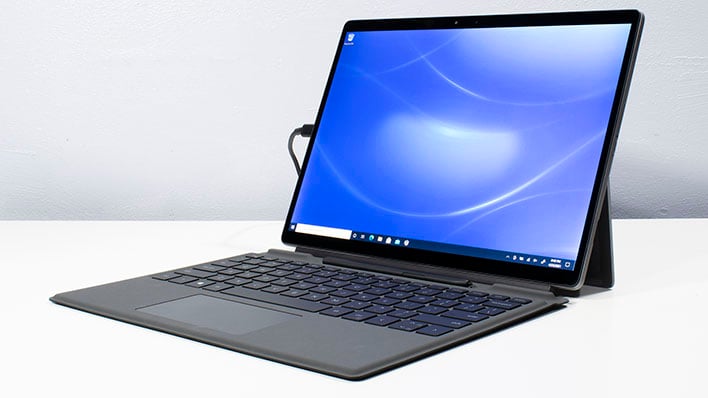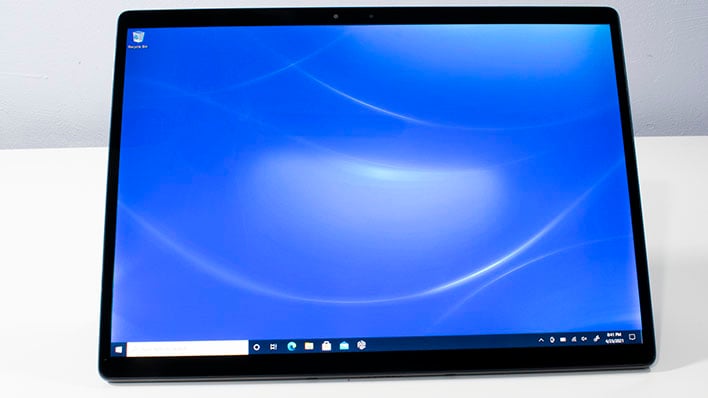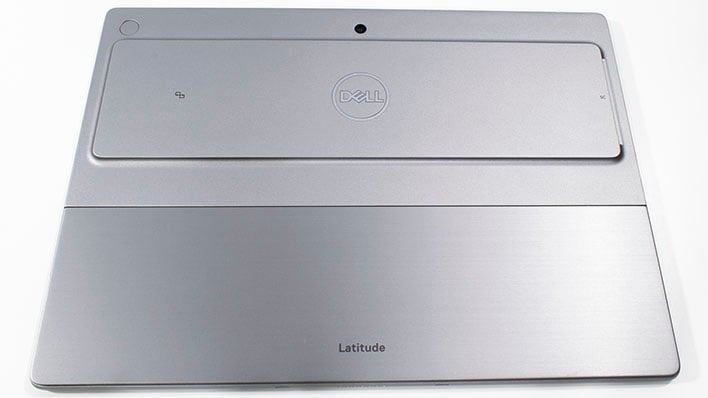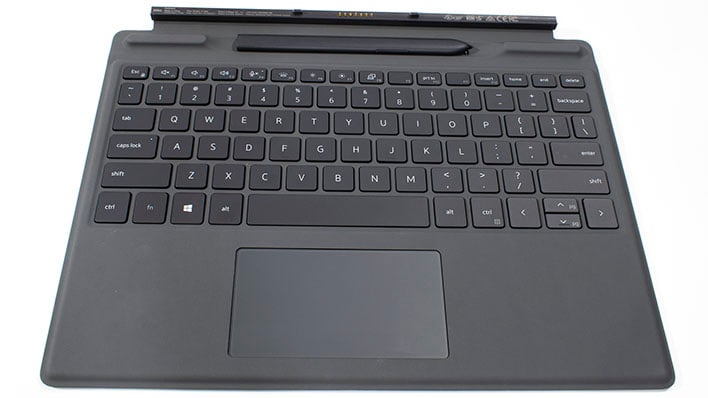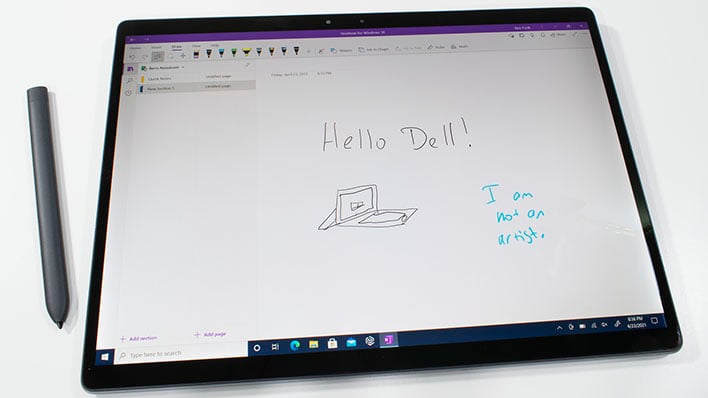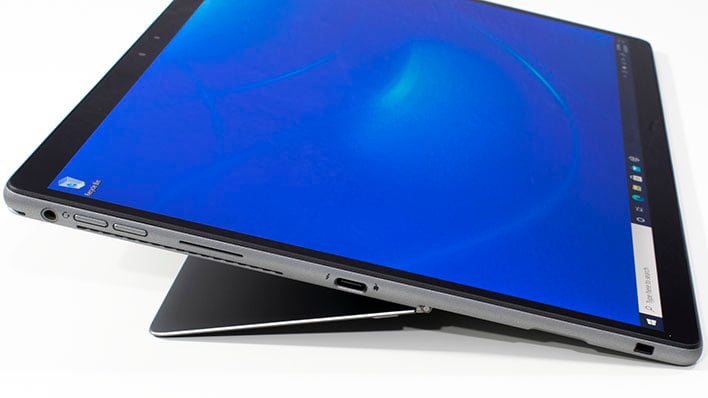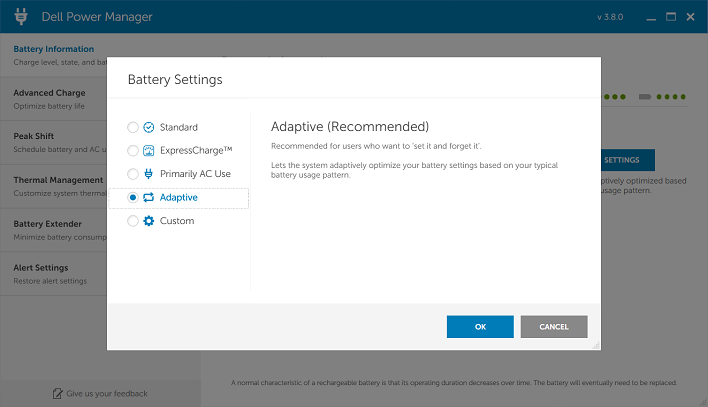Dell Latitude 7320 Detachable Review: Eclipsing Surface Pro
Dell Latitude 7320 Detachable: A Surface Pro 7 Killer?
The detachable hybrid 2-in-1 laptop category may sound somewhat exotic, but these convertible tablet PCs aren't exactly a new thing. Hybrid devices with keyboard docks -- either first-party or made by other manufacturers -- are available that run Android, iPad OS, and of course Windows 10. Perhaps the most well-known detachable hybrids are from Microsoft's long-running Surface Pro family, including the x86-powered Surface Pro 7 and Arm64-equipped Surface Pro X. Dell is now throwing its latest entrant into this arena with the new Latitude 7320 Detachable.
At a quick glance, the Latitude 7320 Detachable is bound to draw some comparisons with the Surface lineup. The Latitude's taller-than-normal 3:2 aspect ratio, magnetic keyboard, and kickstand support system are all common to Microsoft's popular tablet lineup. Dell has some additional tricks up its sleeve, however, as the Latitude 7320 sports a newer Tiger Lake CPU with a higher TDP, Thunderbolt 4 connectivity, and much more. Before we get ahead of ourselves though, let's meet the Dell Latitude 7320...
At the heart of the Latitude 7320 is the Tiger Lake-based Intel Core i7-1180G7. This low-power chip runs with a TDP of 12 Watts, down 20% from the 15 Watt TDP of more common consumer chips like the Core i7-1165G7. Intel gave this processor the same four cores, eight threads, and 12 MB of L3 cache as its higher-powered siblings, however. The same 96-EU Iris Xe graphics engine and other Tiger Lake accoutrements are here, as well. The clock speeds are down a bit, as it has a base clock of 1.2 GHz and maxes out at a 4.6 GHz turbo. There's also vPro technology aboard for remote management, something corporate IT buyers will no doubt appreciate.
Memory comes in the form of soldered LPDDR4-4267 in a dual-channel configuration. While the base model starts with 8 GB of memory, our review unit has 16 GB of RAM. For storage, the Latitude 7320 Detachable starts with 256 GB of solid-state storage and maxes out at 2 full TB. Our review model stops in the middle with a 1 TB PCIe 3.0 x4 drive on an M.2 card. Networking comes in the form of Intel's AX201 802.11ax Wi-Fi 6 module with integrated Bluetooth 5.0. Users who need cellular connectivity can opt for a 4G LTE cellular option.
The big Surface Pro comparison will likely stem from the 3:2 aspect ratio of its 13", 1920 x 1280 display. That's the same aspect that Microsoft puts on its tablets, and depending on the workload, it can be a welcome change from the typical 16:9 1080p on most notebooks. This display has a 177 ppi pixel density, and Windows 10 defaults to 125% scaling, no different than most notebooks. That means this display shows more vertical real estate than similar 16:9 displays, which equates to more of a web page or more lines of code in a text editor. The rear also has a world-facing 8 MP camera that captures 1080p 30 fps video. Both cameras are controlled by Intel's own image processor (IPU 6) that focuses on enhanced color and contrast.
The back of our review unit also has a pretty sizable bump which houses the optional Smart Card reader. Units without the reader won't have the bump. As big as it looks, the tablet only measures 12 millimeters at the bump according to our calibers, which works out to 0.48 inches, so it's still pretty thin. We found it handy to get a grip on the Latitude, though without the reader, we think the lightweight tablet would still be fine to hold onto.
Dell also put a big focus on security when designing the Latitude 7320 Detachable. This tablet has an optional integrated infrared webcam, fingerprint reader, Smart Card slot, and even a contactless NFC sensor for authentication. Many IT departments no doubt need non-password authentication methods like these. When paired with Dell's Endpoint software and VMWare Carbon Black's local sandboxing features, IT staff have a ton of options when it comes to securing hardware.
The aforementioned front-facing IR webcam also has a 5 MP sensor and captures video at 1080p at 30 fps. That's a considerable upgrade from most consumer notebooks that get saddled with 720p sensors, and the difference was immediately apparent in Skype calls. The integrated dual noise-canceling microphone array made sure we could be heard, too. The stereo speakers are tuned out of the box with MaxxAudio Pro from audio plugin company Waves. The EQ curve does its best, but in a tablet this small, the speakers are nothing spectacular. They're plenty to hear callers in Skype or watch the occasional YouTube video, but anything beyond that won't sound too great. Thankfully, there is a headset jack on the side.
Dell also included multiple input methods in the box. The Latitude 7320 Detachable has an optional keyboard accessory with a magnetic pogo pin system. We found that if we just held the keyboard in the general vicinity of the dock, the magnets would spring to life and pull the two together without any fuss whatsoever. The keyboard also has a pair of magnetic pogo pin connectors along the top edge that grab ahold of the (also optional) active stylus. The redundant pogo pins on each side of the connector makes the charger ambidextrous, so both lefties and righties can put down or pick up the active pen without thinking about orientation.
While the stylus dock and keyboard design is pretty innovative, it doesn't provide the greatest typing experience. It supports two different angles, as even more magnets will prop the back end up against the bottom bezel to angle the keyboard deck slightly. However, doing so pulls the keyboard up off the table and introduces an element of bounciness as our heavy-handed typing drummed against the keys. Our keyboard didn't quite sit flat even when it was folded down all the way, so there was always an element of bounce to it. Unfortunately, the keyboard does not come standard with all models of the 7320 Detachable, and when it doesn't, it's an extra $269.99 for the keyboard and stylus combo.
Key travel is pretty shallow, but it's still a far sight better than Apple's "butterfly" switches. We didn't have any dropped keystrokes or doubled inputs, even with the bounce we experienced. The track pad is pretty small, but the screen is touch-enabled, so the size of the track pad is not necessarily bad. The integrated buttons work as expected, and it supports gesture input. Dell markets the accessory as a travel keyboard, and when space is tight, it certainly gets by. At a desk we think we'd prefer to dock the system with one of the two Thunderbolt 4 ports and use a regular USB keyboard and mouse.
Dell gave our tablet the optional active pen, which is normally $99.99 on its own, but at launch will be available for $74.99. The shape of the stylus takes a little getting used to, as it's not perfectly round, but more of an oval shape. We did find that its pressure sensitivity and responsiveness were perfect though. As we took big swipes, we struggled to see any lead that the pen would have over the virtual ink which it spilled, and writing felt very natural.
Besides its somewhat odd shape, another feature that took some getting used to was the side-mounted quick action buttons, which take the shape of a rocker switch. The side closest to the point was automatically mapped to an eraser by OneNote, and we found ourselves erasing as much as we were writing, because the button fits so naturally under the index finger. Flipping the stylus around made sure that we weren't erasing anything, but the buttons weren't as easily accessible. It's something we think that with time, most users will get used to using.
Around the back, the Latitude 7320 Detachable has a kickstand that angles back approximately 120 degrees, giving a wide array of adjustment to the tablet either sitting on its own or while docked. Historically, this made early members of the Surface family difficult to use on a lap, since the kickstand felt unsteady. Unfortunately the same is true here. It's better to use the Latitude 7320 Detachable as a tablet with the kickstand folded in, or on a table with the travel keyboard dock. Those with narrower knees might fare a bit better than we did, but it felt like the tablet was on shaky ground when straddling our thighs.
The first useful utility Dell includes is Power Manager. This includes battery health monitoring, thermal management, and additional power conservation tools like Battery Extender. In the past on notebooks like the XPS 13 2-in-1, we've used Dell Power Manager to toggle Ultra Performance mode for a performance boost at the cost of extra heat and fan noise. While this option is present on the Latitude Detachable, we did not test with it enabled, as that's not really the point of this miniscule device. And as you'll see later on, performance was pretty solid without it.

Dell Optimizer is another useful utility bundled with the 7320 Detachable. This tool can prioritize the performance and network bandwidth of specific applications when they're running. If PowerPoint and Microsoft Teams need the most performance and bandwidth to get the job done, Optimizer will ensure they get CPU cycles and transmitted bits ahead of other apps. It also allows controlling how the Adaptive charging enabled in Power Manager works.

One feature that threw us for a loop is the included proximity sensor. If the PC detects that you've walked away, it will automatically turn off the screen and lock the device, which adds another layer of security to a device that already emphasizes security quite a bit. This is great in an office when people are coming and going from their desks, but maybe not as great when working from home and just walking to the kitchen to get a cup of coffee, or trying to run a video loop battery rundown test. Fortunately, Dell Optimizer handles that, too. It can be snoozed for a period, or disabled entirely. The "wake on approach" feature is neat to see in action, as when we walked into our home office, the device would see us in the doorway and spring to life, and Windows Hello's IR camera integration would handle the rest.
Now that we've become suitably acquainted with the Dell Latitude 7320 Detachable, let's take it for a spin in our benchmark suite...
At a quick glance, the Latitude 7320 Detachable is bound to draw some comparisons with the Surface lineup. The Latitude's taller-than-normal 3:2 aspect ratio, magnetic keyboard, and kickstand support system are all common to Microsoft's popular tablet lineup. Dell has some additional tricks up its sleeve, however, as the Latitude 7320 sports a newer Tiger Lake CPU with a higher TDP, Thunderbolt 4 connectivity, and much more. Before we get ahead of ourselves though, let's meet the Dell Latitude 7320...
|
| Processor | Intel Core i7-1180G7 with vPro (4 Cores/8 Threads: 12 MB L3 cache, 4.6 GHz max, 12W TDP) |
| Display | 13.0" 3:2 FHD+ (1920 x 1280), 500 nits ComfortView Plus, 10-point multitouch, pen support |
| Graphics | Intel Iris Xe Graphics (96 execution units, 1.1GHz) |
| Storage | 1 TB NVMe PCI Express solid-state drive |
| Memory | 16 GB LPDDR4x 4267MHz (soldered) |
| Audio | 2x Stereo Speakers with MaxxAudio Pro |
| Cameras | Front-facing 5 MP with 1080p @30 fps video Support Windows Hello with infra-red World-facing 8 MP with 1080p @30 fps video |
| Networking | Intel Wi-Fi 6 AX201, 802.11ax 2x2 Wi-Fi + Bluetooth 5.1 |
| Ports: Left | 1x USB-C (Thunderbolt 4) 1x 3.5mm headphone/microphone combo |
| Ports: Right | 1x USB-C (Thunderbolt 4) 1x wedge-style Lock Port 1x uSIM slot for optional cellular connectivity |
| Ports: Top | 1x power button with integrated fingerprint reader |
| Ports: Bottom | Pogo pin magnetic dock port for 7320 Detachable Keyboard |
| Keyboard | 7320 Detachable Keyboard with magnetic docking hinge |
| Touchpad | Built into 7320 Detachable Keyboard, integrated buttons |
| Battery | Integrated 2-Cell 40 Whr polymer with ExpressCharge 2.0 and ExpressCharge Boost |
| Weight | 1.82 lbs (tablet only); 2.69 lbs with 7320 Detachable Keyboard |
| Dimensions | Tablet: 11.35 x 8.18 x 0.33 inches (288.4 x 207.9 x 8.44 millimeters) With keyboard: 11.35 x 8.48 x 0.52 inches (288.4 x 215.6 x 13.54 millimeters) |
| Warranty | 1-year mail-in after remote diagnosis; up to 5 year extension available |
| Operating System | Windows 10 Pro x64, 20H2 pre-installed |
| Price | Starts at $1,549 |
At the heart of the Latitude 7320 is the Tiger Lake-based Intel Core i7-1180G7. This low-power chip runs with a TDP of 12 Watts, down 20% from the 15 Watt TDP of more common consumer chips like the Core i7-1165G7. Intel gave this processor the same four cores, eight threads, and 12 MB of L3 cache as its higher-powered siblings, however. The same 96-EU Iris Xe graphics engine and other Tiger Lake accoutrements are here, as well. The clock speeds are down a bit, as it has a base clock of 1.2 GHz and maxes out at a 4.6 GHz turbo. There's also vPro technology aboard for remote management, something corporate IT buyers will no doubt appreciate.
Memory comes in the form of soldered LPDDR4-4267 in a dual-channel configuration. While the base model starts with 8 GB of memory, our review unit has 16 GB of RAM. For storage, the Latitude 7320 Detachable starts with 256 GB of solid-state storage and maxes out at 2 full TB. Our review model stops in the middle with a 1 TB PCIe 3.0 x4 drive on an M.2 card. Networking comes in the form of Intel's AX201 802.11ax Wi-Fi 6 module with integrated Bluetooth 5.0. Users who need cellular connectivity can opt for a 4G LTE cellular option.
Dell Latitude 7320 Detachable Industrial Design
The Latitude 7320 Detachable has a magnesium alloy body that feels very sturdy and high-quality in the hands. Around the sides and top edge, we can see very thin cooling vents to for hot air expulsion. The Latitude 7320 Detachable is actively cooled, and we can feel air wafting from the vents when it's working hard. The front is dominated by an IPS multi-touch display. The bezels are pretty thin all around, but the top and bottom are a little thicker than the sides. That makes it possible to hold the Detachable as a tablet with minimal effort, without obscuring much of the screen.The big Surface Pro comparison will likely stem from the 3:2 aspect ratio of its 13", 1920 x 1280 display. That's the same aspect that Microsoft puts on its tablets, and depending on the workload, it can be a welcome change from the typical 16:9 1080p on most notebooks. This display has a 177 ppi pixel density, and Windows 10 defaults to 125% scaling, no different than most notebooks. That means this display shows more vertical real estate than similar 16:9 displays, which equates to more of a web page or more lines of code in a text editor. The rear also has a world-facing 8 MP camera that captures 1080p 30 fps video. Both cameras are controlled by Intel's own image processor (IPU 6) that focuses on enhanced color and contrast.
The back of our review unit also has a pretty sizable bump which houses the optional Smart Card reader. Units without the reader won't have the bump. As big as it looks, the tablet only measures 12 millimeters at the bump according to our calibers, which works out to 0.48 inches, so it's still pretty thin. We found it handy to get a grip on the Latitude, though without the reader, we think the lightweight tablet would still be fine to hold onto.
Dell also put a big focus on security when designing the Latitude 7320 Detachable. This tablet has an optional integrated infrared webcam, fingerprint reader, Smart Card slot, and even a contactless NFC sensor for authentication. Many IT departments no doubt need non-password authentication methods like these. When paired with Dell's Endpoint software and VMWare Carbon Black's local sandboxing features, IT staff have a ton of options when it comes to securing hardware.
The aforementioned front-facing IR webcam also has a 5 MP sensor and captures video at 1080p at 30 fps. That's a considerable upgrade from most consumer notebooks that get saddled with 720p sensors, and the difference was immediately apparent in Skype calls. The integrated dual noise-canceling microphone array made sure we could be heard, too. The stereo speakers are tuned out of the box with MaxxAudio Pro from audio plugin company Waves. The EQ curve does its best, but in a tablet this small, the speakers are nothing spectacular. They're plenty to hear callers in Skype or watch the occasional YouTube video, but anything beyond that won't sound too great. Thankfully, there is a headset jack on the side.
Dell also included multiple input methods in the box. The Latitude 7320 Detachable has an optional keyboard accessory with a magnetic pogo pin system. We found that if we just held the keyboard in the general vicinity of the dock, the magnets would spring to life and pull the two together without any fuss whatsoever. The keyboard also has a pair of magnetic pogo pin connectors along the top edge that grab ahold of the (also optional) active stylus. The redundant pogo pins on each side of the connector makes the charger ambidextrous, so both lefties and righties can put down or pick up the active pen without thinking about orientation.
While the stylus dock and keyboard design is pretty innovative, it doesn't provide the greatest typing experience. It supports two different angles, as even more magnets will prop the back end up against the bottom bezel to angle the keyboard deck slightly. However, doing so pulls the keyboard up off the table and introduces an element of bounciness as our heavy-handed typing drummed against the keys. Our keyboard didn't quite sit flat even when it was folded down all the way, so there was always an element of bounce to it. Unfortunately, the keyboard does not come standard with all models of the 7320 Detachable, and when it doesn't, it's an extra $269.99 for the keyboard and stylus combo.
Key travel is pretty shallow, but it's still a far sight better than Apple's "butterfly" switches. We didn't have any dropped keystrokes or doubled inputs, even with the bounce we experienced. The track pad is pretty small, but the screen is touch-enabled, so the size of the track pad is not necessarily bad. The integrated buttons work as expected, and it supports gesture input. Dell markets the accessory as a travel keyboard, and when space is tight, it certainly gets by. At a desk we think we'd prefer to dock the system with one of the two Thunderbolt 4 ports and use a regular USB keyboard and mouse.
Dell Latitude 7320 Tablet and Active Pen Experience
As a tablet, the Latitude 7320 provides a fantastic experience. It never felt overly hot as we cradled it, though that's something we'll get into more in the cooling section later on. The Latitude is comfortable to hold, easy to read, and feels nice in the hand. The on-screen keyboard allows for text input, though we'll stick to the travel keyboard or a proper desktop setup with a dock for more extensive typing.Dell gave our tablet the optional active pen, which is normally $99.99 on its own, but at launch will be available for $74.99. The shape of the stylus takes a little getting used to, as it's not perfectly round, but more of an oval shape. We did find that its pressure sensitivity and responsiveness were perfect though. As we took big swipes, we struggled to see any lead that the pen would have over the virtual ink which it spilled, and writing felt very natural.
Besides its somewhat odd shape, another feature that took some getting used to was the side-mounted quick action buttons, which take the shape of a rocker switch. The side closest to the point was automatically mapped to an eraser by OneNote, and we found ourselves erasing as much as we were writing, because the button fits so naturally under the index finger. Flipping the stylus around made sure that we weren't erasing anything, but the buttons weren't as easily accessible. It's something we think that with time, most users will get used to using.
Dell Latitude 7320 Detachable Expandability
Externally, the Latitude 7320 Detachable is pretty diminutive, but it still has a nice port array. On the left side sits a Thunderbolt 4 connector with the familiar USB-C form factor. On the left, there's also a standard analog 3.5mm headset port. On the right, we find a second Thunderbolt 4 connector. At the bottom is a proprietary dock connector for the travel keyboard. Unlike the Surface family, Dell outfitted the Latitude 7320 with USB-C charging with the included 60 Watt adapter. That, with the inclusion of Thunderbolt, opens up a host of docking solutions from a variety of manufacturers, not just Dell, since the Thunderbolt interface is an industry standard, not a proprietary connector.Around the back, the Latitude 7320 Detachable has a kickstand that angles back approximately 120 degrees, giving a wide array of adjustment to the tablet either sitting on its own or while docked. Historically, this made early members of the Surface family difficult to use on a lap, since the kickstand felt unsteady. Unfortunately the same is true here. It's better to use the Latitude 7320 Detachable as a tablet with the kickstand folded in, or on a table with the travel keyboard dock. Those with narrower knees might fare a bit better than we did, but it felt like the tablet was on shaky ground when straddling our thighs.
Dell Latitude 7320 Detachable Software Experience
As we'd previously mentioned, the Latitude 7320 is running full-fat Windows 10, the Pro edition in our case. Dell pre-loaded the system with the 20H2 update and installed very little beyond the drivers and a few useful utilities. We always appreciate when a system comes without a bunch of bloatware and trial software, as is the case here. While not the friendliest tablet operating system, Windows 10's dedicated tablet mode makes using the system simple enough to get around using nothing but fingertips and the touch interface.The first useful utility Dell includes is Power Manager. This includes battery health monitoring, thermal management, and additional power conservation tools like Battery Extender. In the past on notebooks like the XPS 13 2-in-1, we've used Dell Power Manager to toggle Ultra Performance mode for a performance boost at the cost of extra heat and fan noise. While this option is present on the Latitude Detachable, we did not test with it enabled, as that's not really the point of this miniscule device. And as you'll see later on, performance was pretty solid without it.

Dell Optimizer is another useful utility bundled with the 7320 Detachable. This tool can prioritize the performance and network bandwidth of specific applications when they're running. If PowerPoint and Microsoft Teams need the most performance and bandwidth to get the job done, Optimizer will ensure they get CPU cycles and transmitted bits ahead of other apps. It also allows controlling how the Adaptive charging enabled in Power Manager works.

One feature that threw us for a loop is the included proximity sensor. If the PC detects that you've walked away, it will automatically turn off the screen and lock the device, which adds another layer of security to a device that already emphasizes security quite a bit. This is great in an office when people are coming and going from their desks, but maybe not as great when working from home and just walking to the kitchen to get a cup of coffee, or trying to run a video loop battery rundown test. Fortunately, Dell Optimizer handles that, too. It can be snoozed for a period, or disabled entirely. The "wake on approach" feature is neat to see in action, as when we walked into our home office, the device would see us in the doorway and spring to life, and Windows Hello's IR camera integration would handle the rest.
Now that we've become suitably acquainted with the Dell Latitude 7320 Detachable, let's take it for a spin in our benchmark suite...

